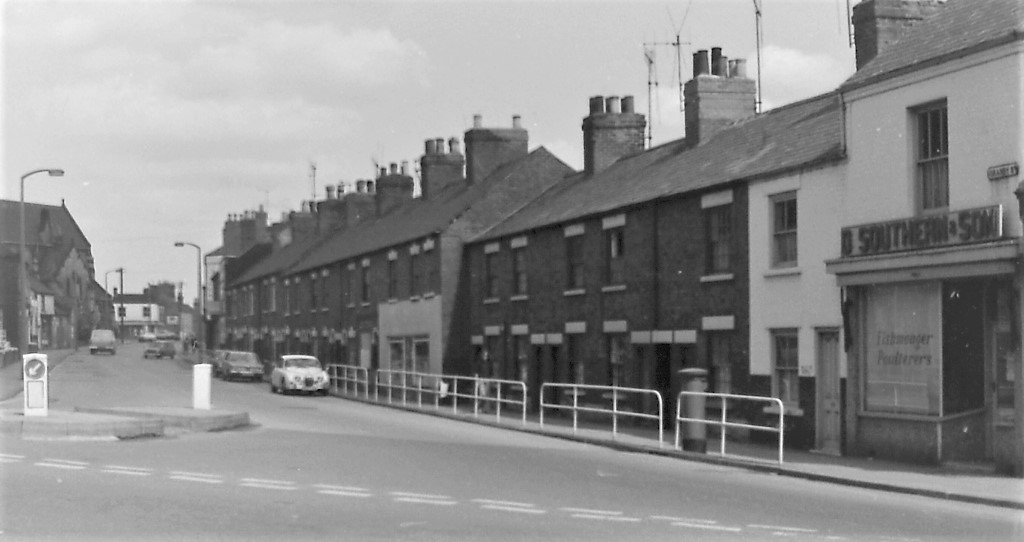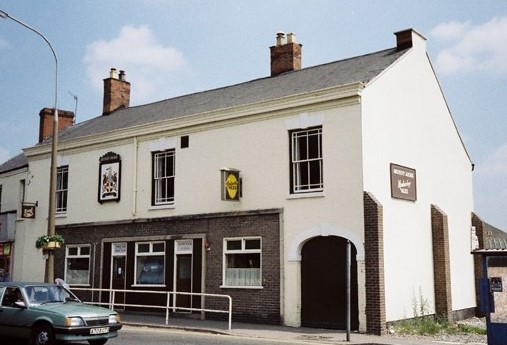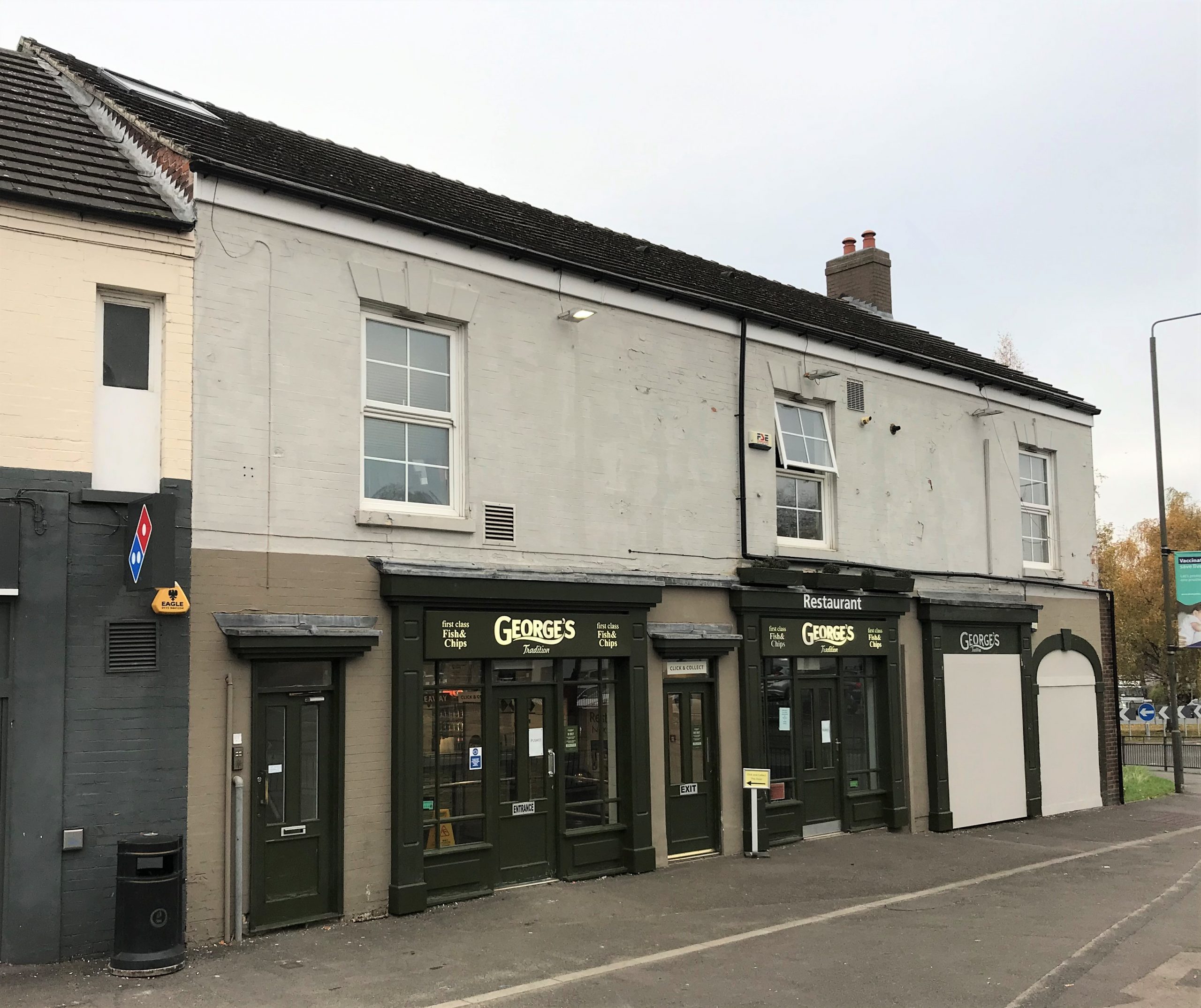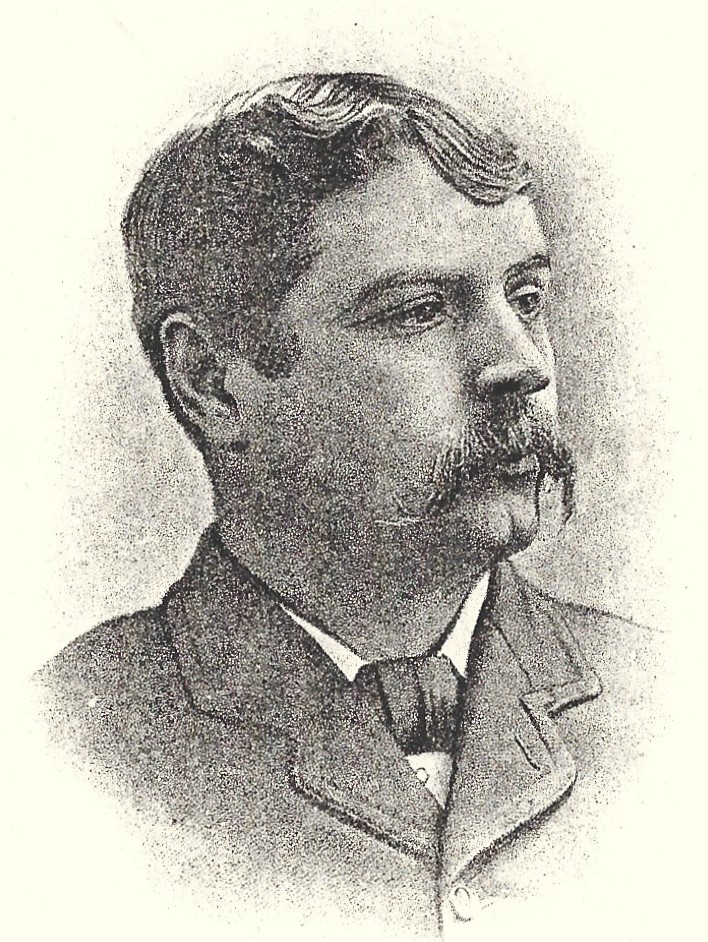Here we are looking down into the Common (courtesy of Jim Beardsley) … standing at the junction of Bath Street (right) and Heanor Road (left) with Granby Street before us.
On our right (just behind us) is the Mundy Arms and in the distance (left) is Holy Trinity Church.
————————————————————————————————————————————————
“On the east side of Bath Street, on the edge of the Common was the Mundy Arms, kept by Mr. H. Clay.”
Henry Levers Clay was the son of gardener John and Ruth (nee Levers), born in 1818 at Shipley where, when a young man, he traded as a plumber and glazier.
In June 1843 he married Ann Belfield, daughter of Shipley labourer Joseph and Mary (nee Boam) and seems to have moved into Bath Street in the mid 1850’s.
There he also traded as a beerhouse keeper and later innkeeper of the Mundy Arms.
Henry also held property on the north side of Awsworth Road, previously known as Coal Pit Lane. He had bought this as copyhold land in February 1867 and in December of the same year he enfranchised it.
In the early years of the nineteenth century it had been occupied and then owned by James Potter (coal merchant and brother of Samuel) whose sisters Elizabeth and Mary both married Alexander Mellor Barker — but not at the same time !! Both had died but Alexander had continued to live at this property until his death in 1852. James Potter had died in 1822 and in his will left the property to his son-in law, surgeon Francis Nathaniel Greene — the latter had married Betty Phillips, the illegitimate daughter of James Potter and Sarah Phillips, in May 1842. On the 1841 census the premises were occupied by Alexander Mellor Barker whose niece, by marriage, was Betty Greene. (nee Phillips) — on this census it appears in the area known as ‘Middle Lane‘.
Francis Nathaniel Greene had died on November 13th 1862 and so Henry Clay acquired the property in 1867 from his elder son Frank Nathaniel Greene.
—————————————————————————————————————————————–
The Clay children.
John Belfield Clay was their oldest child who, after his marriage to Kettering-born Mary Jane Pollard in 1868, worked as a maltster living in Awsworth Road, trading at Eastwood and later at Ilkeston.
The process of malt making requires three stages …
a) the grain is steeped in a large cistern
b) it is then spread on a wooden floor to germinate
c) it is then dried in a kiln.
Thus, three separate areas are needed in a malt-house –a cistern house, a couching (drying) house, and a kiln house with a furnace underneath. John Belfield Clay had such a malt-house, from about 1870, at the junction of what is today Lower Granby Street and Mundy Street. (His son John Henry would later use it).
By 1884 John had found his way to Long Eaton but late that year he was in financial difficulties. In January 1885 he was scheduled to appear at Derby Bankruptcy Court but missed his ‘appointment’. The judge was not pleased (putting it mildly) … John’s case had escalated in its seriousness, and it was now punishable with imprisonment. The matter was adjourned until the next court, when John would have to explain his absence … or else ?
John did make an appearance at the next court … in February 1885 … where he admitted to taking several risks in business and in life generally, and had bet a little but not lost extensively. His case continued, and in early November of that year his bankruptcy dividend payment was declared.
This was of little interest or importance to John however; he died at his Awsworth Road home on November 5th, 1885, aged 42.
Almost exactly two years later, his widow, Mary Jane, died.
Louisa Belfield Clay was the eldest daughter and she remained unmarried. After the death of her father in October 1896, she left the Mundy Arms to live at the family property, at 202 Awsworth Road, and dying there on March 2nd, 1925, aged 79.
Mary Belfield Clay, his eldest daughter, married Gilbert Wilkinson, Pork Butcher, writes Adeline.
However Mary Belfield Clay was Henry’s second daughter who, on September 5th, 1876, married pork butcher Gilbert Wilkinson whose shop was close to the Mundy Arms.
Interestingly, their marriage entry shows the bride as ‘widow Mary Belfield Hart’, the reason for which can be traced to events about ten years earlier.
On a Tuesday morning in March 1865 16-year old Mary left home as usual for her school, the Wilton Academy of Elizabeth Long in Wilton Place, but did not return home for dinner as usual. Her parents became uneasy.
Father Henry quickly made enquiries, discovered where his daughter was and made all haste to Babbington Chapel, three miles away, across the border, near Awsworth.
But he was too late.
Earlier Mary had made her way there with ‘22 year-old’ John Hart (or was he 35?), a guard on the Ilkeston branch of the Midland Railway, and the couple were married at the chapel.
By the time Henry arrived the fugitive pair had already departed.
But he was not prepared to take this lying down — nor in any other position — and Henry’s temper had not cooled by that evening. This was unfortunate for Amos Lane, butcher and occasional music and dance teacher, who was returning by cart to Ilkeston from his dancing school in Heanor about midnight and who was accosted by a furious Henry at the bottom of Bath Street.
The innkeeper had discovered that Amos had been at his daughter’s clandestine wedding and demanded to know where she now was.
Some choice language and oaths were followed by a scuffle in the street, blows were struck and in the mêlée Amos’s violin and its case were damaged.
All this was witnessed by several customers at the Mundy Arms who had come out of the premises, determined not to miss the potentially entertaining confrontation.
In the court case resulting from this affray Henry agreed to pay for the damages and there that matter rested.
In the meantime Henry swore out a warrant against his unwanted son-in-law John Hart.
The charge against the latter rested in the Marriage and Registration Act of 1856 which ordered that if a person under the age of 21 wished to marry, then the consent of the minor’s father or guardian needed to be given.
It was claimed that John had wilfully made a false declaration when applying for his marriage licence. He had stated that Henry had given his consent for the marriage as Mary was under the age of 21.
Henry denied this — no consent had been obtained and he was totally unaware that any marriage was about to take place.
Two days later Superintendent Shaw traced the newly-weds to Nottingham where, armed with the warrant, he took John into custody while an unhappy Mary was returned to her parents.
During the next two weeks, preliminary hearings were held at Smalley Petty Sessions and then Derby County Hall before John was committed for trail at Derby Assizes on a charge of perjury.
There was a great deal of local public support for John, including from many prominent trades people and in March a defence fund was set up for the accused.
At the subsequent trial John was described by his counsel as ‘a suitable husband in every way’; he had been employed by the railway company for over six years, had been promoted several times with consequent increases in pay, and had managed to save about £400. His employer saw him as ‘a young man of steady, industrious character’.
The judge suggested to Henry that he might agree to the marriage but both the innkeeper and his wife were set against it…. their daughter was ‘but a little girl’.
Eventually a verdict of not guilty was returned by the jury.
John knew that Mary was not 21 but believed that her father had given his agreement to the marriage…he had not wilfully lied when applying for a licence.
Gap alert!! What happened to John Hart subsequent to his acquittal in July 1865?
It seems that Mary was returned to the care of her parents and the 1871 census lists ‘Mary Clay‘, unmarried daughter of Henry Clay at the Mundy Arms, 65 Bath Street.
Seven years after ‘the marriage that wasn’t’ and Henry Clay – he of the long memory and unforgiving nature — was still unhappy with Amos Lane… the innkeeper was now charging Amos with driving a cow, infected with foot and mouth disease, along a public highway.
Case dismissed.
———————————————————————————————————————————————–
The Wilkinsons
Let us pause here to meet this Wilkinson family.
Pork butcher Joseph Wilkinson came from Belper to return to Ilkeston, the place of his birth, in 1860, with his wife Mary (nee Jennison) and six children, and settled in very close proximity to the Mundy Arms, at the junction of Bath Street and Granby Street.
Gilbert was the oldest child … born in Belper on January 7th, 1850. As a young man and before his marriage, he travelled to reside, for a few years, at Monongahela, Pennsylvania
When Mary Belfield Clay married Gilbert in 1876 she didn’t have to move far to join her husband … and his brothers Joseph and Samuel !!!
Traffic warning! …. 9.30 am March 24th 1881. (taken from the Derby Mercury)
The light trap of pork butcher Gilbert Wilkinson and boot and shoe maker Frederick Mitchell was travelling at speed down Bath Street when, near the Poplar Inn, it collided violently with an omnibus/cab driven by Richard Birch Daykin who had just picked up a passenger at the Midland Railway station.
The trap and its horse were overturned, its shafts broken and the two occupants thrown six or seven yards away.
The shafts of the ‘bus were also broken and the baskets carried on its top were hurled to the ground.
Gilbert was quick to recover but Frederick had to be carried unconscious into the Inn, where he received medical assistance. (… and a whisky chaser?!)
Was Gilbert taught to drive a trap by his father-in-law ?!!!
Traffic warning ! …. January 23rd 1888, just after 1 pm … in his pony cart, Alderman Henry Clay was travelling to Park Farm, the home of his daughter, Annie Belfield Potter (widow of farmer John Cecil Potter). With him he had two grandchildren, Bertie (Gilbert Marcus) and Willie (William Cullen) Wilkinson, aged 6 and 3 respectively — sons of Gilbert and Mary Belfield Wilkinson. They were turning into Park Road from Market Street, too quickly, such that the cart overturned and pitched the occupants out into the street. The horse, which had a reputation for being troublesome, then shot off, down Park Road and only stopped a mile or so later, when it reached the farm.
Meanwhile Henry and the two lads, now with numerous cuts, bruises and grazes, had been rescued from the road. The youngsters, though shaken, quickly recovered, but there was more concern for Henry, now almost 70. Dr. Albert Roland, Henry’s son-in-law, was sent for and administered the bandages etc. before the three injured were transported home
Gilbert was a member of the old Local Board, and in 1904 unsuccessfully contested for a seat on Derby County Council. He was a freemason, a nonconformist Conservative (not a usual combination)
Gilbert died on Tuesday, December 8th, 1908 .. unexpectedly, of a heart attack, at ‘Branscombe’, his home in Heanor Road. Three years earlier he had a serious bicycle accident (!!!) and had never fully recovered — it seems to have led to a serious but gradual and sustained decline in Gilbert’s health. He was buried in Park Cemetery after a service at Holy Trinity Church, attended by relatives, friends and many freemasons.
—————————————————————————————————————————————-
Second son Henry Belfield Clay lived unmarried with his parents at the Mundy Arms. He traded as a plumber and from June 1887 was licensed victualler at the Mundy Arms, when the license was transferred from his father.
When the latter died at the Mundy Arms in 1896 Henry Belfield lived with sister Louisa at 202 Awsworth Road and died there in March 1915, aged 63.
“Annie Belfield Clay became Mrs. Potter and lived sometime at the Park.”
The next daughter, Annie, married John Cecil Potter, youngest son of Samuel and Ann (nee Streets) of the Park on November 29th, 1881. Her husband died in 1885 after which Annie’s father Henry managed the farm at the Park for his widowed daughter.
About the spring of 1886 Annie employed Alice Fletcher, a young lass of 13, to be her general servant around the house. Her mistress found Alice amicable and was soon on good terms with her; she seemed trustworthy and honest, a little strange to begin with but that soon passed.
A year later, on Sunday, March 27th 1887, Annie left her home about six o’clock in the evening to attend evening service at St. Mary’s church, taking her two infant children — Annie and Maud Lillian — with her. Later, having left church and visited her married sister Sarah Jane, she was then returning to her own home, just after 8 o’clock, when she was met in Bath Street by servant Alice, who had been sent by Annie’s father Henry Clay. Almost every day, after supervisng affairs at his inn, Henry looked after the farm for his daughter and slept there every night. On that Sunday evening, while he was tending the animals, Alice came to him to tell him of a fire that had broken out in a large haystack — and it was large !! It contained about 30 tons of hay, the produce of 20 acres of land, and was worth about £120. So, ordered by Henry, Alice hurried off to fetch her mistress but seemed extremely calm when she met Annie and announced that a large haystack at the Park farm was on fire. Annie rushed home to find her father had tried, valiantly but vainly, to ‘rescue’ the stack; the hay was almost totally consumed by the fire and although the fire engine arrived shortly after, only a small portion could be saved.
A few days later Alice was outside playing with the two children in the garden, but soon it was ‘time for a bath and bed’. The infants came in only very shortly to be followed by Alice who, once more, told her mistress that the stack was on fire !! — though as it transpired, it was only some hay, lying by the barn, that was smoking. Annie rang the alarm bell and two neighbours arrived very shortly to extinguish any flames. They were soon followed by father Henry on his daily visit, though he arrived to find the fire had been put out. However what he also found was a partly-consumed match close by, a match which was very similar to those kept in the kitchen — and which Alice had access to and would use within the house !!
On both occasions the police attended at the Park and eventually Alice was questioned; she vehemently denied any involvement in any arson. Eventually she left town to return to her aunt’s house in Eastwood, though ‘chased’ by Sergeant Handley who quickly transported her to the lock-up at Langley Mill. A confession, of sorts, was than extracted from her; she admitted accidentally setting fire to the haystack on Sunday but dened responsibililty for the second fire.
At her subsequent trial Alice was found guilty of arson was sentenced to six months in prison, “to do as much hard labour as is given children to do” She was then 14 years old.
Annie kept six tame pet rabbits on her farm, and on August 5th, 1894 went to feed them, only to discover them gone. She quickly reported the loss and the police were equally quickly on the case. Collier Benjamin Lowe was identified as the thief and taken into custody where he was to await trial at the Winter Assizes. Only four rabbits were recovered but Benjamin asserted that he had caught them in the lane near Park Farm. At his trial no-one believed him and he was found guilty. Now, what do think his punishment was ? He had already spent 67 days in custody so the Judge thought he should take this into account. Benjamin got another two months in prison … with hard labour !!
Annie’s had thus recovered two-thirds of her pet menagerie, though I am not aware that they were exhibited at the first Ilkeston and District Fanciers’ Show, held in John Shaw’s Croft at White Lion Square in October 1894, (just as Benjamin was starting his two months) though it was open to rabbits as well as dogs, poultry and pigeons. It was sponsored by the newly-formed Ilkeston Fanciers’ Association.
Rabbits were not the only animals kept by Annie — she also had four dogs in her ‘menagerie’ including a large black retriever, all of which, in July 1895, took a distinct dislike to Alfred Culliner, who was trying to deliver a letter to Annie at her Park home. All four attacked Arthur but it was the retriever which bit his arm, occasioning a visit to Dr, Wood — and a certificate of proof that he had been bitten. Annie claimed that the ‘bite’ was a mere scratch, and that the dogs were excited when the postman had tried to whip them. But that was only in self-defence, argued Arthur.
Herbert Smith, Annie’s neighbour at the Larklands house, claimed that he had had similar unpleasant encounters with all the dogs — also followed by a complaint to Annie and a visit to Dr. Wood.
What was a mere scratch to Annie was a serious bite to the Court; Annie was ordered to have the dog ‘destroyed’ and pay costs of £1 2s.
Annie Belfield Potter lived the last 50 years of her life at 201 Awsworth Road where she died, on August 11th, 1949, aged 93. (Her large semi-detached house was on the east side of Awsworth Road, equi-distant from Springfield Garden and Spring Garden Terrace) Her estate was inherited by her two spinster daughters.
“Sarah Jane, the youngest daughter married George Barker, Draper, Bath Street”
The youngest daughter was Sarah Jane and Bath Street draper George Barker was her second husband.
She had married her first husband, surgeon Albert Glen Murray Roland, in May 1880 and the couple lived ‘comfortably’ in private rooms, close to her parents, for 18 months.
Only a month after the marriage Sarah Jane slipped on the steps of her pantry — her injuries were sufficiently severe as to warrant the consistent attention of two doctors for several days, after which she recovered her health. The episode was reported in the Pioneer (June 24th) and considering the subsequent development of this marriage, perhaps some suspicions arise ?
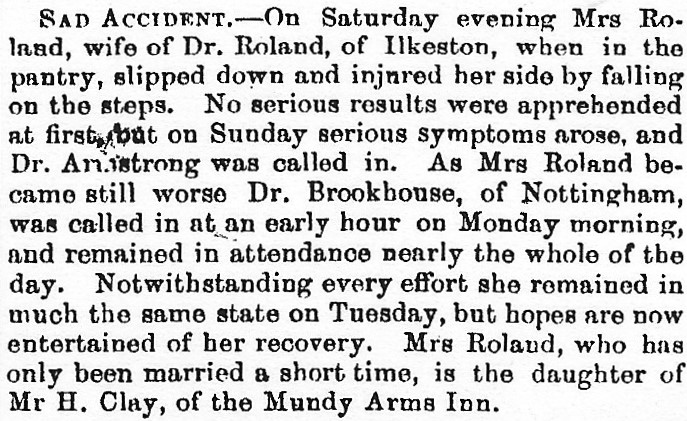
The couple then moved into other rooms in the same street by which time Albert’s physical mistreatment of his wife had begun.
A second move in 1886 found them renting rooms above the Bath Street shop of butcher William Twells but persistent abuse and assaults continued, sometimes born out of Albert’s jealousy and belief that Sarah Jane was ‘unfaithful’. According to the latter this treatment had led her to be in fear of her life at times, such that in September 1888 she applied for a judicial separation, accusing the surgeon of assault.
At the subsequent Petty Sessions hearing, through his solicitor, Albert complained of ‘very great provocation’ and alluded to ‘everyday squabbles’ and reciprocal accusations.
But the Bench did not buy his attempts to deflect blame and he was convicted of assault, fined with costs — or one months’ imprisonment with hard labour — and ordered to pay 10s weekly towards Sarah Jane’s maintenance after an order for judicial separation was granted.
Albert had also been visiting Miss Lizzie Richards at Awsworth after the separation and possibly before — but not in a professional capacity.
In January of the following year Albert was back in Court, accused of disobeying the magistrate’s order to pay maintenance for Sarah Jane. By that time he had left Ilkeston, was unable to find business elsewhere and was destitute.
“His mind was completely unhinged by the unhappy difference with his wife, and he was not considered responsible for his actions”. (DM).
The Bench was sympathetic but not sufficiently so, and determined that the law must take its course.
Thus Albert’s next month was spent in Derby jail but without hard labour.
However upon release he continued to disobey the maintenance order, though his increasingly erratic behaviour led him to be certified of unsound mind and be removed to Mickleover Lunatic Asylum in April 1889.
In the following month, on the grounds of her husband’s cruelty and adultery Sarah Jane was granted a decree nisi, that being made absolute in November 1889.
Albert died in 1890 (at the Asylum?) and on Christmas Eve of that year Sarah Jane married her second husband when her marriage entry described her as ‘spinster’.
Sarah Jane’s second husband, George Henry Barker, was the youngest son of Albion Place lacemaker Samuel Sargent Barker and Hannah (nee Crooks) and was the nephew of George Barker of Malin House in St Mary Street, the Registrar of Births and Deaths.
Thus his aunt by marriage was Mary Barker (nee Malin) whose first husband was William Twells and whose son was Bath Street butcher William Twells junior, mentioned above.
All the Clay children were granted their mother’s maiden name of Belfield as a given name.
————————————————————————————————————————————————–
Henry’s brush with the Law.
1] In December 1877 14-year-old John Reeves and 12-year-old Thomas Winfield entered the Mundy Arms where the latter ordered ‘two squibs of rum’.
They were served by Henry’s daughter Sarah Jane, paid the 3d for the rum, and went into the tap room.
This transaction led to the licensed victualler appearing at Ilkeston Petty Sessions a month later where he was charged with selling rum to a boy under 16 years of age, to be consumed on the premises.
Henry’s defence was that the boys had told his daughter that the drink was for someone waiting at the front door, a usual habit amongst his customers.
Although the offence was proved, the case was dismissed as it was an act of inadvertence.
The two boys had not been so lucky when they had both appeared at the same Petty Sessions a fortnight earlier.
In order to pay for their drink the lads had stolen a shovel, the property of a navvy and valued at 3s, and had fenced it on to general dealer Edward Ashford of Granby Street at the knock-down price of 1s — some of which they had spent on confectionary before adjourning to the Mundy Arms for their alcoholic nightcap.
Thomas was imprisoned for three days and given 12 stripes with a birch rod. The instigator of the crime and previously of good character, John was committed for trial at Derby Quarter Sessions where he was sentenced to 14 days in prison.
2] Henry Clay senior had been elected as a member of the Local Board in April 1879 and had continued as such until April 1882 when he failed to secure his re-election.
The Ilkeston Advertiser was gleefully sarcastic at this news.
“Mr. Henry Clay was certainly dismissed by the ratepayers, if ever a man was dismissed in this world.
“He was not even at the head of the defeated competitors.
“His assiduity and energy were not appreciated by the ungrateful townspeople for whom he had toiled and moiled during twelve weary months.
“Horrid blurters-out of unseasonable suspicions were so base as to challenge the purity and disinterestedness of his actions.
“Short-sighted mortals who could not recognise a great philanthropic soul when before them, did not distinguish between father and son….”
The ‘unseasonable suspicions’ of the voters who had rejected Henry referred to the rumours circulating the town, concerning Henry’s business dealings with the Local Board on which he served.
In 1880, when Frederick Shaw had built a retort house at the Board’s Gas Works in Rutland Street, it was claimed that Henry was sub-contracted to do the plumbing and glazing work there and had received payment for it.
However Henry had been a member of the Local Board from 1879 and as such was disqualified from accepting contracts or profiting under that body.
And this wasn’t the first Board contract that Henry had worked upon.
It was argued that he had also laid on gas and water at the Board’s stables in Pimlico, repaired a pump at the Town Hall for the Board, fixed a water-cart and worked on some lamps at the Town Hall, and the list went on and on.
Shortly after Henry’s disappointing defeat at the 1882 election, a seat on the Board became vacant when Matthew Hobson resigned – his second wife Jemima was seriously ill. Henry was invited by a majority of the other members to rejoin the Board and fill the vacancy …. and he didn’t need asking twice!!
He accepted the invitation.
However one member of the Board was certainly not happy with this.
Charles Mitchell, grocer of Hallam Fields, consistently raised the legality of Henry’s position, his actions and his close business connections with the Board. Charles was one of those who “did not distinguish between father and son”.
He was a constant thorn in the side of Board members and of Henry Clay and William Hawkins in particular. He held no truck with ‘jobbery’ and attacked what he saw as illegal practices at every opportunity.
To support his claims about dubious payments to Board members Charles asked for sight of the Accounts…. Henry however suggested that ‘Mr. Mitchell should put the Accounts where the monkeys put their nuts.
And so at Derby Nisi Prius Court in February 1883 Henry Clay senior stood accused by Charles Mitchell of contravening the Public Health Act of 1875.
We have seen that iron-founder William Hawkins of the Rutland Foundry was accused of the same offence at the same time and had agreed to resign from the Local Board.
However Henry senior was made of sterner stuff and refused to resign or compromise, perhaps certain of his own innocence.
One alternative interpretation of his actions was that he was more bloody-minded — either blind to his misdemeanours or thinking that he might get away with them.
Henry’s defence was that he had retired from the family plumbing business in December 1877, leaving his son Henry junior in charge. There was no written evidence of this business transfer and certain facts were laid before the Court to show that Henry senior was still ‘in charge’, at least up to the end of 1881.
However Henry senior was adamant that he had done no wrong.
It was Henry junior who had tendered for all this work and Henry junior was the one who had been paid for it. Any invoices made out to ‘Henry Clay’ were meant for his son and although the firm’s books were all in the father’s handwriting he had never received a farthing from the business since 1877.
Henry senior may have done some of the work but he was only helping out his son!
At least thast was his defence.
And not unsurprisingly all of Henry senior’s defence was supported and corroborated by Henry junior.
The jury spent all of a few seconds in consideration before finding against Henry and penalising him £100.
Henry resigned from the Board a few days later.
Henry Levers Clay died at the Mundy Arms on October 4th 1896, aged 77.
His wife Ann had died there in June 1888, aged 71.
Close to the Mundy Arms, in the early 1860’s, was the house of the police superintendent, his family and police force.
Behind the house was the town lock-up. This had been built by Thomas Hives.
“Rutland Street was merely a road which led into fields”.
Until the Gas Works were built there?
———————————————————————————————————————————————-
William Mellor on the Common.
“The Common was next.” … states Adeline
Adeline seems to be locating the southern limit of the Common at the bottom – that is the north end — of Bath Street.
“The last shop and house that stood on the Common was owned by Mr. William Mellor, butcher, and it looked very picturesque as it stood under the trees.”
‘The picturesque last shop and house on the Common’ was at 3 Granby Street where lived the family of butcher William Mellor junior, son of William and Rhoda (nee Palmer) and so brother of South Street bachelor butcher John.
In January 1852 he married Ann Boden of Morley, daughter of John and Ann (nee Woolley) and they spent all their married life in Granby Street.
In the early 1860’s William junior was a member of the ‘gallant 16th Derbyshire’ Volunteer Corps.
Ann died in October 1870, aged 51 from typhoid, and in 1876 William married again, to Bakewell-born Matilda Argile.
At the end of the century the Mellor family was still living at 3 Granby Street by which time William was a retired butcher.
———————————————————————————————————————————–
As we are about to venture into Ilkeston Common area and parts of Cotmanhay, and as we have just visited one of the last of our Ilkeston public houses, let’s bring together some of what we now know about Victorian Ilkeston’s drinking places, people, rules and regulations

